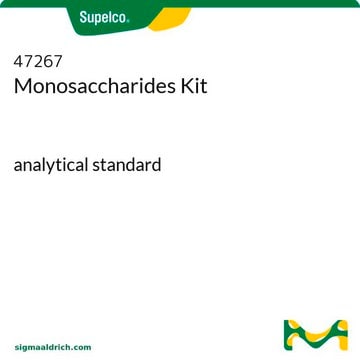91852
D-(+)-Cellobiose
analytical standard
Synonim(y):
β-D-Glc-(1→4)-D-Glc, 4-O-β-D-Glucopyranosyl-D-glucose
About This Item
Polecane produkty
klasa czystości
analytical standard
Poziom jakości
Próba
≥98% (HPLC)
aktywność optyczna
[α]/D 34±1°, c = 10 in H2O
okres trwałości
limited shelf life, expiry date on the label
klasy chemiczne analitów
oligosaccharides
mp
239 °C (dec.) (lit.)
Zastosowanie
food and beverages
format
neat
ciąg SMILES
OC[C@@H](O)[C@@H](O[C@@H]1O[C@H](CO)[C@@H](O)[C@H](O)[C@H]1O)[C@H](O)[C@@H](O)C=O
InChI
1S/C12H22O11/c13-1-4(16)7(18)11(5(17)2-14)23-12-10(21)9(20)8(19)6(3-15)22-12/h1,4-12,14-21H,2-3H2/t4-,5+,6+,7+,8+,9-,10+,11+,12-/m0/s1
Klucz InChI
DKXNBNKWCZZMJT-WELRSGGNSA-N
Szukasz podobnych produktów? Odwiedź Przewodnik dotyczący porównywania produktów
Opis ogólny
Zastosowanie
- Training, testing, and external validation of the gradient retention model developed in ion chromatography using the artificial intelligence-quantitative structure retention relationship (QSRR) model approach.
- Amperometric detection of the analyte in anion-exchange chromatography using copper/cupric oxide nanostructured electrode.
D-(+)-Cellobiose may be used as an analytical reference standard for the quantification of the analyte in caramel samples using gas–liquid chromatography coupled to mass spectrometry (GLC–MS).
Kod klasy składowania
11 - Combustible Solids
Klasa zagrożenia wodnego (WGK)
WGK 3
Temperatura zapłonu (°F)
Not applicable
Temperatura zapłonu (°C)
Not applicable
Choose from one of the most recent versions:
Masz już ten produkt?
Dokumenty związane z niedawno zakupionymi produktami zostały zamieszczone w Bibliotece dokumentów.
Klienci oglądali również te produkty
Nasz zespół naukowców ma doświadczenie we wszystkich obszarach badań, w tym w naukach przyrodniczych, materiałoznawstwie, syntezie chemicznej, chromatografii, analityce i wielu innych dziedzinach.
Skontaktuj się z zespołem ds. pomocy technicznej









